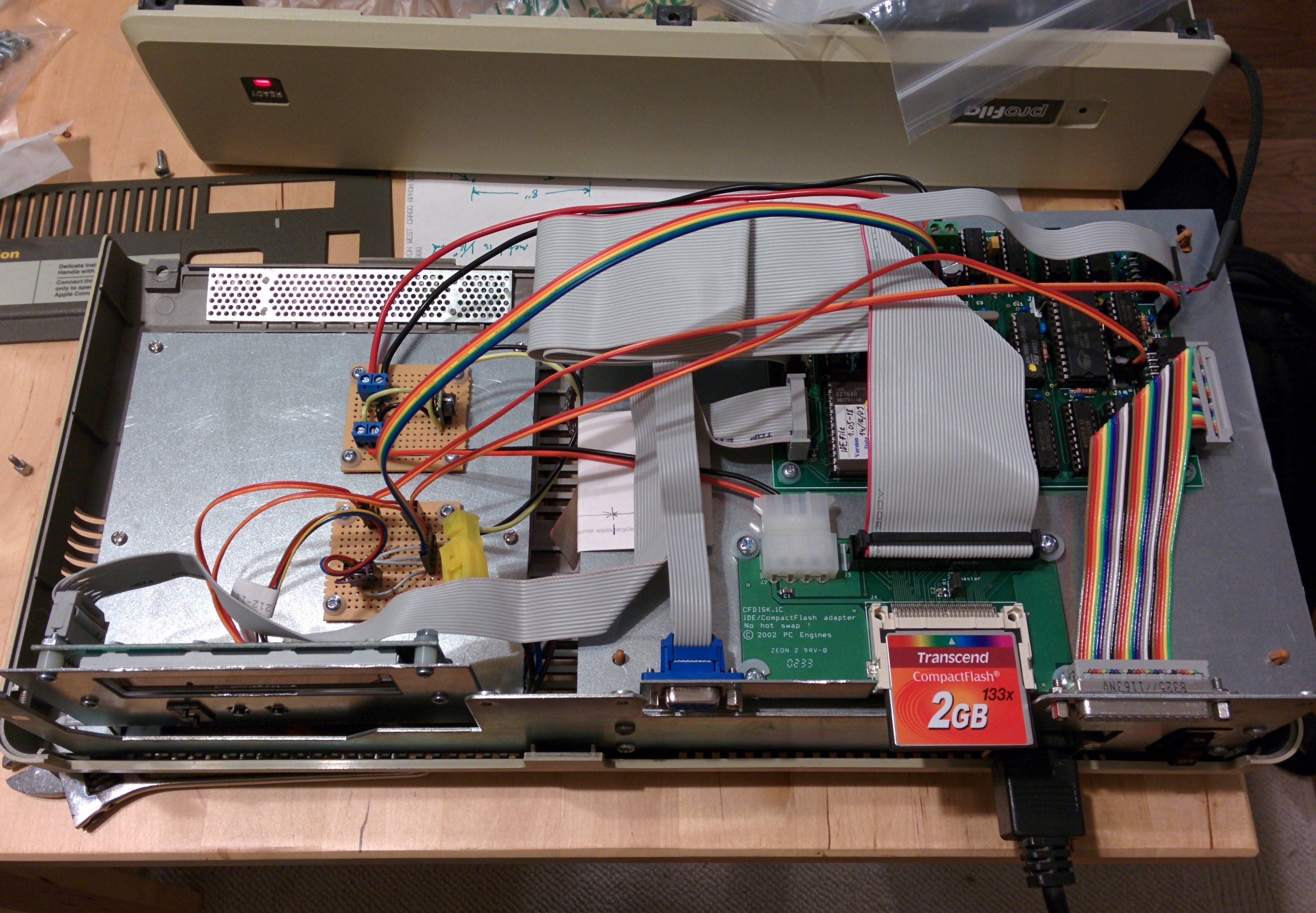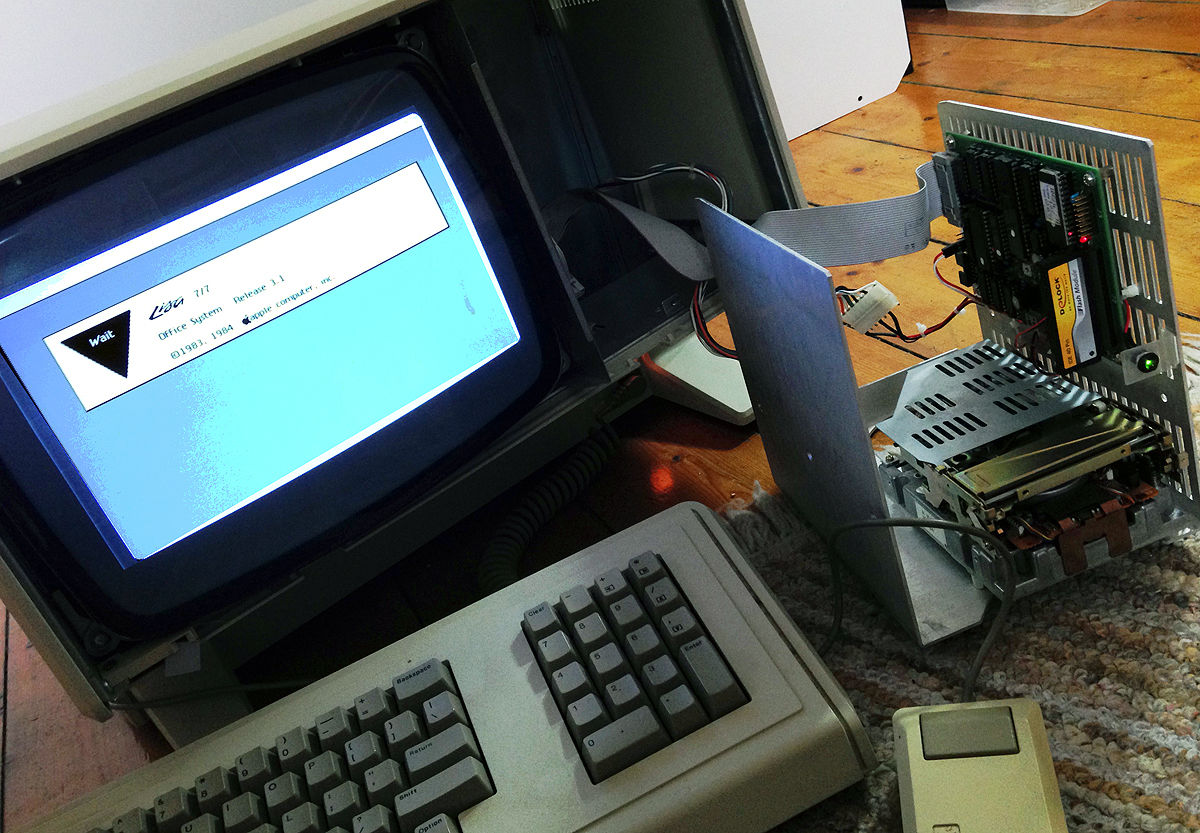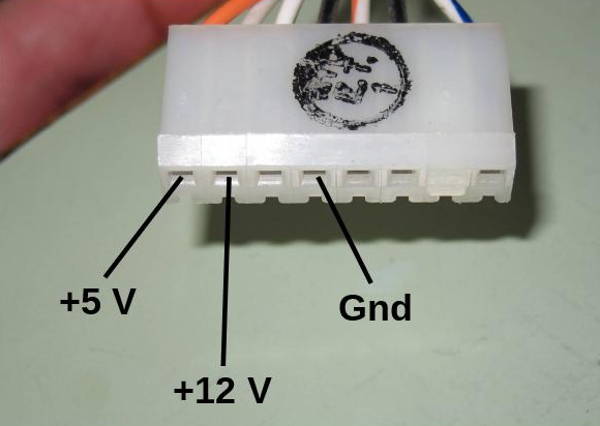created 04.06.2005, last changes: 2023-05-21 ps

>>> Frequently Asked Questions <<<
This file summarizes some of the most popular questions I have been asked concerning IDEfile. Besides that, some information is collected here that did not fit into the main article.
- "Do you sell kits or complete systems?"
No, I don't. If you need a ready-to-run drive for your Lisa, go to Vintage Micros Inc. or Sun Remarketing. These people run a professional business, I do not. IDEfile is indended as a hobby project only.
Since November 2005, the X/Profile is available from Sigma Seven Systems Ltd (the people who designed the XLerator board). It is not cheap, but it comes completely assembled and tested and is therefore a good alternative for people who don't know which side of the soldering iron should be touched ;-)
- "I live on the moon. Can I buy all the required parts in my local electronic store?"
IDEfile does not use any uncommon parts, therefore everything should be available - at least per mail order. If you live in or close to Germany, the de.sci.electronics FAQ contains a list of potential suppliers.
The only exception are the GALs. You can by them at your favourite electronic store, but, as I did not disclose the JEDEC files, you'll have to contact me to get them burned. This is a precaution that allows me to keep track of the units built and that makes it more difficult for people who did not understand the copyright section to start a mass production and charge collector's prices at eBay.
- "I don't own a GAL and/or EPROM burner. Can I get programmed chips from you?"
If you send me your chips, you'll get them programmed for free and pay only the shipping costs back to you. If I have to provide the chips, I will charge you the (somewhat rounded) cost price. Today (May 2023) this is EUR 10,- plus shipping.
- "I don't want to etch my own PCB. Can I get one from you?"
From time to time I do a batch order at a PCB pool manufacturer. If I have some on stock, a PCB bareboard with stop mask and silkscreen printing costs EUR 25,- (plus shipping).
- "How can I pay for my chips & PCB?"
SEPA money transfer to my bank account, in Germany COD (Nachnahme), outside Germany PayPal. International Money Orders do not work any more, Deutsche Post AG cancelled this service many years ago.
Paypal charges a transaction fee of 35 cent plus 5%, which has to be added to the amount sent. So for a value of 55 Euro, your total would be EUR (55 + 0,35) * 1.05 = EUR 58,10. Compare this to your bank fees for SEPA OUR -- usually SEPA wins in the European Union and Paypal is cheaper for the rest of the world.
To get an impression of the shipping costs, look at DHL and Deutsche Post. Within Germany Maxibrief (big letter, up to 1 kg) is the most economic way. If you want tracking, chose Maxibrief Einschreiben (registered letter). International shipping is only possible by DHL (or comparable courier services), because since January 1st 2019 it is not allowed anymore to ship goods within letters. At least not as an individual, different regulations apply to companies. Unfortunately this significantly increases shipping costs - the cheapest package to the US (2 kg including tracking) is around EUR 20,-.
The following pictures show two ways to mount your IDEfile board. Tom Stepleton has used a ProFile case for his system. Display and volume selector switch (a thumbwheel switch like the SCSI ID setting) are located on the back, so no permanent modifications to the housing were necessary. The ProFile power supply needs a minimum load to operate properly, otherwise its voltages are unstable and too high. Therefore a small switchmode regulator module ("7805 replacement") has been used to generate the stabilized +5 V required for board and CF card from the ProFile's 12 V line. The CF card has also been mounted on the back so that it can be easily removed if necessary. Some ideas how to make regular backups of your data are described below ;-).
Two other ways to mount your IDEfile: using a ProFile housing (left image, © Tom Stepleton) and inside the Lisa drive cage (right image, © Peter Weno).
 |
 |
Peter Weno just screwed his board (fitted with a DOM module) to the ventilations slots on the side of the card cage. His Lisa is a 2/10, therefore parallel port and power cables were already there. For a 2/5 you will need to run the parallel cable from the Lisa's rear into the card cage. Power can be tapped from the second (unused) floppy cable, as described above. A piece of plastic material was used as a support for the Ready LED. With the attached front cover everything looks like a real Lisa 2/10 -- except for the missing grinding noise of the Widget.
- "Can I use a drive that has been formatted by an Apple III with a Lisa and vice versa?"
SOS and LisaOS are different operating systems, therefore the drive has to be reformatted before it can be used with the other machine. This is done by the SOS System Utility or by the LisaOS installer disk respectively. The drive does NOT need low-level formatting, only the new file system has to be created.
- "When does my drive need low-level formatting?"
After you swapped the drive mechanism, the read/write amplifer, and after you adjusted the motor speed or the servo circuit. Besides that, low-level formatting may help refreshing old drives where the address field information faded and all spare blocks have been allocated.
For a ProFile, you can check how many spares have been used by watching the power-on self test: Remove the top cover, switch it on and wait. After 18 seconds the stepper motor
will move from its park position to track 77, then to track 0. After that, a surface scan of the disk is performed. You will see the step motor rotating slowly while the heads travel from track to track. Sometimes the heads jump to track 77, then the scan continues. This means a bad sector has been found. The drive does not access this sector, it uses a spare sector instead. These are located on track 77, and 32 are available.
Now watch the surface scan and count the number of movements towards the spare track. A new drive uses 0..2 spares, 3..5 is means fine condition. With more than 10 spare sectors used you should look for someone with low-level formatting tools.
IDEfile does neither require nor support low-level formatting, because it uses a commercial IDE drive and this delegates the task towards the drive manufacturer. In case you have to completely remove an old software installation, use the 'Z' command.
- "How is this mysterious low-level formatting done?"
In the Usenet, many interesting stories around this topic can be found, and many people are proud to present their half-knowledge. Therefore I will explain this process here in detail.
Low-level formatting means writing the low-level protocol data on a magnetic disk that is completely empty. This protocol data consists of synchronization gaps, adress marks, address fields, data marks and data fields. After that, you have a disk with tracks and sectors. Usually, low-level formatting is done at the manufacturer's site, because special equipment is needed. From now, only the data fields on the disk will be modified! The address fields are never touched again.
High-level formatting means assigning these sectors to clusters, zapping their data fields, and creating a kind of data structure (FAT, HFS, ext2 or whatever) around them. This is what the PC's "format c: /u" command does.
A ProFile can be formatted with a regular Apple ///. Additional hardware is not required, only software (a disk for the /// and a Z8 CPU for the drive). This is possible because the ProFile with its stepper motor has everything on board that is needed to position the read/write heads on the disk. In contrast to this, modern drives don't know where to put their voice coil arm on a brand-new disk, because they use the protocol data on the tracks as a position guide. They need an external laser interferometer as a navigation aid.
Profile Format Procedure:
* Remove cover of profile. Insert Profile I/O card into slot 1 on Apple ///.
* Remove controller chip (U25) from Profile controller board. Insert the
formatter chip in its place.
* Connect I/O cable to Apple ///. Connect a LED to the LED output on the
controller board.
* Power up the profile. When the stepper arm rotates clockwise to track 0,
insert format program and power on the Apple ///.
* The LED should turn on. Put a jumper across vertical pins located between
U23 and U24.
* You should see a message like "INCORRECT FD.ROM VERSION D3.11". This is
correct and you should proceed by pressing return.
* The Profile should begin to format.
* When instructed to remove the jumper, do so.
* If the following tests pass, the Profile has been formatted.
* Remove format ROM and insert standard controller chip.
* Insert the FST program diskette and power up the Profile and Apple ///.
* This test must run for 48 hours.
* 10-08 04 00 and 30-08 00 00 errors are allowed.
* If FST passed, perform a System Utilities format. The Profile is ready
for use.
Formatting a Widget requires an Apple /// running the "Widget Utility" tool. This program steps through the tracks, erases them, and writes sector headers and data fields. After that, the spare table is generated (there are two of them, one on each surface) and a bad block scan is performed. Unlike the ProFile, Widgets have all diagnostic commands embedded in their standard firmware. There is no need to swap ROMs.
While ProFile employs a simple step motor to position the heads (like a floppy disk drive). Widget uses a more sophisticated voice coil system controlled by a servo circuit. There are two light barriers attached to the head arm, which scan a line pattern on a glass scale attached to the chassis. During formatting, the drive has to rely entirely on this optical positioning system. Later, when data is available on the disk, automatic track following is used for fine positioning. The Quantum ProDrive LPS series (Apple HD40, HD80) use the same technology.
Usually the alingment of the optics has to be checked and adjusted before formatting can be performed. To adjust the servo board, Apple used an Apple ][ with "SVO Writer" card and Dan Retzinger's "Apple to Servo" tool.
Note: I do not sell or distribute copies of the formatter software or formatter chips !!! However, if your drive needs formatting and you live close to Germany, you may contact me. Or build your own UsbWidEx ProFile/Widget Debugger!
- "What can I do when formatting does not help?"
Profile: If your unit passes its selftest after formatting, but fails again after a week or two, something in the electronic has almost died. Check all voltages from the PSU (use an oscilloscope to look for ripple), check and clean the connectors, check the rotational speed of the drive. The exact value (3600 rpm) is not critical, but there should not be any fluctuations. Electrolytic capacitor are a common cause for this kind of fault.
In case the formatting routine does not succed or the unit fails immediately after formatting, the hard disk mechanism may be damaged. Big drives do not like to be moved or shaken during operation, so a head crash may have occurred. You can replace the mechanism with the one from a Seagate ST-412 drive (used in the IBM XT). This is a 10MB unit, but nevertheless you will get only half of the capacity in a 5MB ProFile. 5MB and 10MB units differ by their data rate and the number of sectors per track.
Replacing the magnetic disks inside the drive mechanism is a job for the hardcore hobbyist only. You can use almost any disk that is designed for inductive heads, e.g. from a ST-225. I did this once many years ago, but that time I worked in a lab with a dust-free class-100 clean room. The fixed drive worked for quite long time, long enought to finish my emulator.
Widget: After the motor came up to speed, at first the servo performs a selftest. The light flashes and the arm moves once over the disk. If this test is passed, the controller begins with the high-level tests, scanning the tracks and verifying the integrity of the spare tables. This means: if the drive starts up, the LED flashes and you hear a ticking sound, but then the lamp goes off, you need re-formatting.. If the lamp flashes and you hear a single squeak, the servo seems to be alive but may need alignment. Besides that, there may be a problem with the RW or controller board. If you hear a banging noise or nothing at all, the servo circuit is broken.
In any case: never open the housing to have a look at the disks! This is a certain way to ruin the drive. One exception: in case you hear something ratteling inside when the drive is shaken, the glass scale came off. It can be glued back into place, but this has to be done in a dust-free environment.
- "MacWorks does not recognize my IDEfile volume at all, or does not recognize the full capacity!"
Use the 'z'ap command to erase the volume. It seems that the installer can be disturbed by old data structures on the disk. This is not an IDEfile specific issue, it applies to all drive types.
- "MacWorks Plus does not boot MacOS when the IDEfile is connected!"
Any boot floppy is rejected with the 'crossed disk' icon, and MacWorks frequently reads block $0182 + $0187 from disk, letting IDEfile's Ready LED flash.
Disconnect the drive until MacOS has been fully loaded from floppy. Then reconnect it and run MW_Install to install MacWorks onto the harddisk. This is not an IDEfile specific issue, it applies to all drive types.
- Xenix issues:
The ProFile driver of Lisa Xenix 3.0 has a bug that may cause handshake errors when used with a device that is significantly faster than the original ProFile: it asserts -PCMD before enabling the interrupt that should be triggered by the falling edge of -PBSY! If the drive is fast enough and has already set -PBSY in the meantime, this falling edge will never be detected, resulting in a timeout or a hanging Lisa.
SigmaSeven Systems have explained this in detail here, and they also provided a patch for the ProFile driver. Though I have never observed this effect in practice with my drives, I strongly recommend using the patch. However, the first part, "a) To always send 6 command bytes", is not required by IDEfile and can be omitted.
Besides that, Xenix has another interesting feature: the drive size is assumed based on the ID of the I/O Board ROM of the machine. So a Lisa 2/5 with the A8 ROM requires a 5MB drive, and a 2/10 with an 88 ROM needs 10MB to operate correctly.
----> Back to the IDEfile page
----> Back to my home page
IDEfile is copyright (c) by Dr. Patrick Schäfer, 2004
Apple, Lisa, ProFile, Widget and the ProFile communications protocol are (c) by Apple Computer Inc.
This page is hosted at John, a server of the Computer Club der RWTH Aachen e.V.




